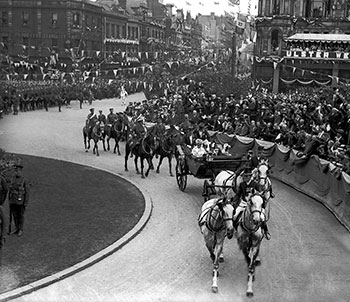100 YEARS AGO: Long committee creates two Home Rule parliaments
Published in UncategorizedBy Joseph E.A. Connell Jr

Above: George V in Belfast for the opening of the Northern Ireland Parliament in June 1921, the most lasting legacy of the Long committee’s recommendations, enshrined in the 1920 Government of Ireland Act. (Alamy)
With the end of the First World War in November 1918, and with Sinn Féin winning a majority of Irish seats in the December general election, the British government faced its obligation under the Home Rule suspensory measure of 1914 to return to the Irish question. It became apparent that it had to adopt many of the recommendations contained in the March 1918 Irish Convention Report; a fourth Home Rule Act was required.
Pressure was added in January 1919 when 27 Sinn Féin MPs assembled in Dublin and proclaimed themselves unilaterally to be the parliament of an independent Irish Republic. This was ignored by the British, and the War of Independence ensued.
There was further delay because of the Versailles peace conference, which concluded in July 1919. The parliamentary summer recess followed, so that when the cabinet’s designated ‘Long committee for Ireland’ began its work in September 1919 it was nearly a year behind political events in Ireland. Its chairman, Walter Long, a firm unionist, felt free to shape Home Rule in Ulster’s favour and formalised the division of Ireland, with separate parliaments for North and South.
In the meantime, Dublin Castle was confronted from 21 January 1919 with the separatist Dáil Éireann and attacks on Crown forces. The Long committee decided by October 1919 that two Irish parliaments should be established, including a Council of Ireland, which was a mechanism for the ‘encouragement of an Irish unit’. The committee thereby adopted many of the recommendations contained in the March 1918 Irish Convention Report.
By February 1920 Ulster unionist politicians stated again that they would only claim six counties, Long having offered them a deal (in return for their votes) ‘that the Six Counties … should be theirs for good … and no interference with the boundaries …’.
The resulting Fourth Home Rule Bill, enacted as the Government of Ireland Act (1920), which closely followed the Long committee’s report, received royal assent on 23 December 1920 and came into effect on 3 May 1921 with the elections to the two new Home Rule parliaments for Northern Ireland and for Southern Ireland. The latter parliament for the 26 counties never met as such, however, and was replaced under the Anglo-Irish Treaty by the Irish Free State.
The Parliament of Northern Ireland, really the result of the Irish Convention, opened on 22 June 1921 and was portrayed as a loyalist triumph for years of patriotism and sacrifice. The paradox was that Ulster Unionists now had the Home Rule system that they had opposed since the 1840s, ideally preferring to remain within the United Kingdom. At its opening in Belfast City Hall, King George V made a famous appeal, drafted by Prime Minister Lloyd George, calling for Anglo-Irish and north–south reconciliation, but the Anglo-Irish Treaty had provided for Northern Ireland’s parliament to opt out of the new Free State, which was a foregone conclusion.
Home Rule did not die in 1916, in 1918 or in 1921. It enjoyed a form of afterlife in Northern Ireland until 1972.
Joseph E.A. Connell Jr is the author of The shadow war: Michael Collins and the politics of violence (Wordwell Books).
















